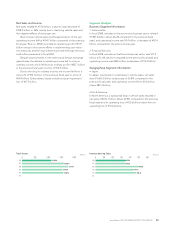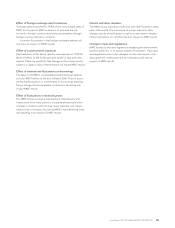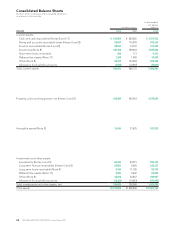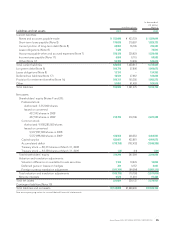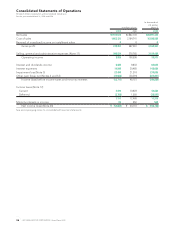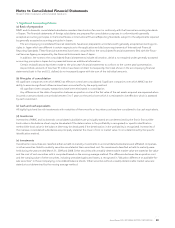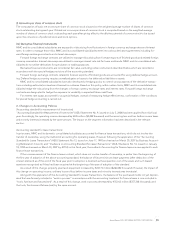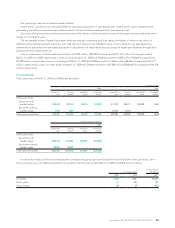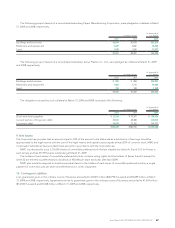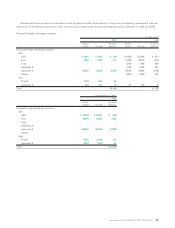Mitsubishi 2009 Annual Report Download - page 43
Download and view the complete annual report
Please find page 43 of the 2009 Mitsubishi annual report below. You can navigate through the pages in the report by either clicking on the pages listed below, or by using the keyword search tool below to find specific information within the annual report.
(l) Amounts per share of common stock
The computation of basic net income per share of common stock is based on the weighted average number of shares of common
stock outstanding during each year. Diluted net income per share of common stock is computed based on the weighted average
number of shares of common stock outstanding each year after giving effect to the dilutive potential of common stock to be issued
upon the conversion of preferred stock and stock options.
(m) Derivative financial instruments
MMC and its consolidated subsidiaries are exposed to risks arising from fluctuations in foreign currency exchange rates and interest
rates. In order to manage those risks, MMC and its consolidated subsidiaries enter into various derivative agreements including for-
ward foreign exchange contracts and interest rate swaps.
Forward foreign exchange contracts are utilized to manage risks arising from forecast exports of finished goods and related foreign
currency receivables. Interest rate swaps are utilized to manage interest rate risk for loans and bonds. MMC and its consolidated sub-
sidiaries do not utilize derivatives for speculation or trading purposes.
Derivative financial instruments are recorded at fair value, excluding certain instruments described below which are recorded in
accordance with the special hedge provisions of the accounting standard.
Forward foreign exchange contracts related to forecast exports of finished goods are accounted for using deferral hedge account-
ing. Deferral hedge accounting requires unrealized gains or losses to be deferred as liabilities or assets.
MMC and its consolidated subsidiaries have also developed a hedging policy to control various aspects of the derivative transac-
tions including authorization levels and transaction volumes. Based on this policy, within certain limits, MMC and its consolidated sub-
sidiaries hedge the risks arising from the changes in foreign currency exchange rates and interest rates. Forward foreign exchange
contracts are designated to hedge the exposure to variability in expected future cash flows.
For interest rate swaps accounted for as special hedges, instead of measuring hedge effectiveness, confirmation of the conditions
for special hedge accounting is carried out.
2. Changes in Accounting Policies
(Accounting standard for measurement of inventories)
“Accounting Standard for Measurement of Inventories” (ASBJ Statement No. 9, issued on July 5, 2006) has been applied from this fiscal
year. Accordingly, the operating income decreased by ¥245 million ($2,499 thousand) and the recurring loss and loss before income taxes
and minority interests increased by the same amount. The impact on the segment information has been described in the relevant
section.
(Accounting standard for lease transactions)
In prior years, MMC and its domestic consolidated subsidiaries accounted for finance lease transactions, which do not involve the
transfer of ownership, using the method of accounting for operating leases. However, following the application of the “Accounting
Standard for Lease Transactions” (ASBJ Statement No.13, issued on June 17, 1993 and revised on March 30, 2007 by Business Account-
ing Deliberation Council), and “Guidance on Accounting Standard for Lease Transactions” (ASBJ Guidance No. 16, issued on January
18, 1994 and revised on March 30, 2007 by JIPCA) in this fiscal year, the method of accounting for finance leases is now applied to such
finance lease transactions.
If the commencement of the finance lease contract, which does not involve transfer of ownership, is earlier than the beginning of
the first year of adoption of the above accounting standard, the balance of future minimum lease payments (after deduction of the
interest element) as of the end of the fiscal year prior to adoption is deemed as the acquisition cost of the asset, and such leased
assets are recognized as if they had been acquired at the beginning of the year of adoption of the standard.
As a result of this change, property, plant and equipment increased by ¥24,172 million ($246,082 thousand). However, the impact of
this change on operating income, ordinary loss and loss before income taxes and minority interests was immaterial.
Along with the application of the Accounting Standard for Lease Transactions, the balance of the purchased molds not yet depreci-
ated that was formerly included in “work in process” in accordance with the accounting treatment for finance lease is now included in
“tools, furniture and fixtures (net)”. As a result of this change, work in process decreased by ¥35,102 million ($357,348 thousand), and
the tools, furniture and fixtures (net) by the same amount.
41
Annual Report 2009 MITSUBISHI MOTORS CORPORATION


